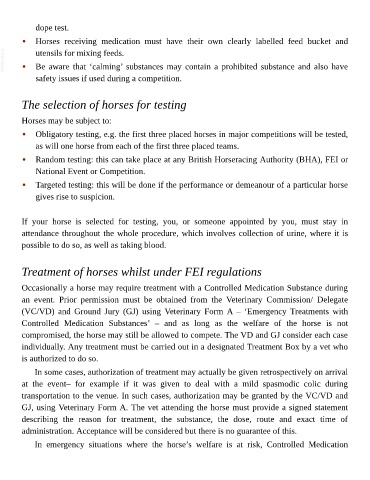Page 1139 - The Veterinary Care of the Horse
P. 1139
dope test.
• Horses receiving medication must have their own clearly labelled feed bucket and
VetBooks.ir • utensils for mixing feeds.
Be aware that ‘calming’ substances may contain a prohibited substance and also have
safety issues if used during a competition.
The selection of horses for testing
Horses may be subject to:
• Obligatory testing, e.g. the first three placed horses in major competitions will be tested,
as will one horse from each of the first three placed teams.
• Random testing: this can take place at any British Horseracing Authority (BHA), FEI or
National Event or Competition.
• Targeted testing: this will be done if the performance or demeanour of a particular horse
gives rise to suspicion.
If your horse is selected for testing, you, or someone appointed by you, must stay in
attendance throughout the whole procedure, which involves collection of urine, where it is
possible to do so, as well as taking blood.
Treatment of horses whilst under FEI regulations
Occasionally a horse may require treatment with a Controlled Medication Substance during
an event. Prior permission must be obtained from the Veterinary Commission/ Delegate
(VC/VD) and Ground Jury (GJ) using Veterinary Form A – ‘Emergency Treatments with
Controlled Medication Substances’ – and as long as the welfare of the horse is not
compromised, the horse may still be allowed to compete. The VD and GJ consider each case
individually. Any treatment must be carried out in a designated Treatment Box by a vet who
is authorized to do so.
In some cases, authorization of treatment may actually be given retrospectively on arrival
at the event– for example if it was given to deal with a mild spasmodic colic during
transportation to the venue. In such cases, authorization may be granted by the VC/VD and
GJ, using Veterinary Form A. The vet attending the horse must provide a signed statement
describing the reason for treatment, the substance, the dose, route and exact time of
administration. Acceptance will be considered but there is no guarantee of this.
In emergency situations where the horse’s welfare is at risk, Controlled Medication

